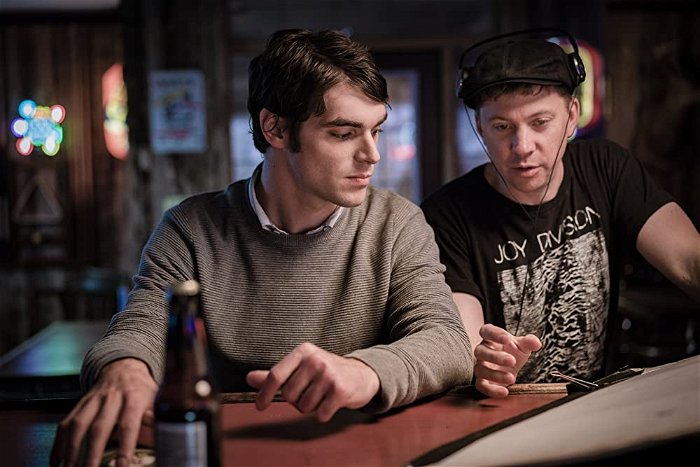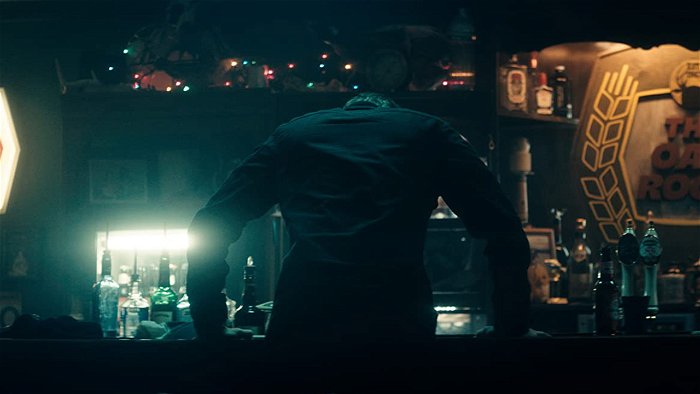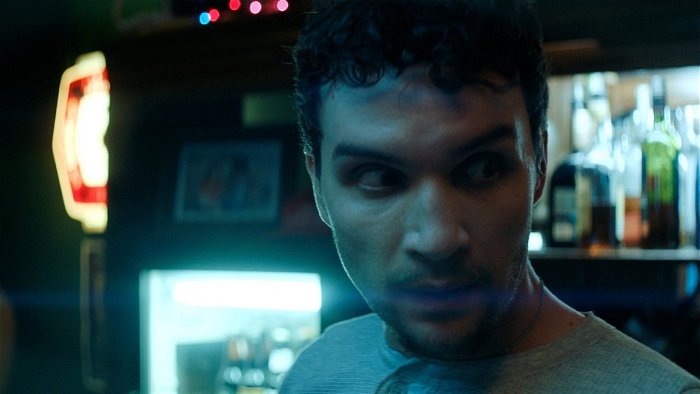Canada is a unique place. It is filled with such vibrant settings from the big cities to the rolling hills. But one thing few places can compare to is the brutal loneliness of the Canadian north. This is a place where anything can happen, and few would know the outcome. People can get lost, or dark deeds can be committed with no one being the wiser. This is the setting and feel of The Oak Room, a new thriller that embodies the brutal loneliness that northern Canada represents.
The Oak Room is a unique work that captures the brutal isolation in a way few films can. Adapted from a play, the film uses limited sets and claustrophobic spaces to convey tension and menace. We got a chance to talk with director Cody Calahan along with star RJ Mitte when the film first premiered at last year’s Fantasia Festival.
Discussing everything from genre filmmaking to bringing the unique brutality of the cold white north to life within Hamilton, the conversation is an enlightening look at Canadian filmmaking and the world of genre it represents.
CGMagazine: I want to quickly start off by discussing how this project began and how both of you got involved?
Cody Calahan: It originated as a stage play, it was written by Peter Genoway back in 2013, I think it premiered at the Fringe festival in Toronto. And one of the actors in it, Ari Millen, who plays Michael, who actually plays Michael in the movie, is one of my oldest friends, and he sent me the script way back and just thought it would make a really good film and wondered if I’d be interested in adapting it. But the idea of adapting a stage play seemed a little big at the time. And so, he bugged me for a few years and then a couple of years ago he sent it to me again and said, “you just really got to read this.” So, I sat down, and I read it and it was instantly, “okay, I see what you mean.”
From there we set up a meeting with the writer and started discussing how to take it from a stage play to a screenplay and what to keep and what to add. And I would say 90% the stage play was retained; we knew we wanted it to be a dialogue driven character driven piece and not take away from what was beautiful with the stage play. When it came to casting, we knew the movie would revolve around Steve and Paul and their relationship, and we started thinking of ideas, and RJ was one of them and we sent him the script and yeah, you can take it from there.
RJ: Cody reached out to me and wanted to see if I was interested. For me, one of the big things is as much as it’s a heavy dialogue production there were also a lot of subtleties in the moments of silence. That’s what I look at when it comes to a script, is this air of environment that encompasses these people, and I really was drawn to that. I could see the vision that Cody wanted because it’s what you see when you watch the movie. That’s my key factor in looking for work. And I jumped on and I was interested, and it just kept growing from there. And here we are with the final product.

CGMagazine: I want to just touch on the look and the feel of the film. It has a very brooding tone and one that really sets the stage for what’s about to happen as you enter each scene. How does that style come to be? And I also want to mention to RJ, how did you bring that character to life? And what about it helped it fit that tone?
RJ: It really was a Testament to the team that all had the same creative vision and they worked so cohesively together that it just made it all possible for me to just live. Peter, who played this amazing grizzly dude, really helped embody this as well. The Oak Room’s casting was perfect, the background was perfect, the crew was perfect. It was a perfect storm in itself, and I was very lucky to just be able to hold still in this and not get blown away.
“The Oak Room’s casting was perfect, the background was perfect, the crew was perfect.”
Cody Calahan: Originally, I was pretty adamant about finding real locations just due to the story. I wanted the actors to feel that they were actually in real places and real scenes. I also knew I wanted to approach it with long takes. I think we got a couple takes that might’ve been between 10 and 15 minutes long, where we just let the actors be immersed in the characters. And you could see them after a few minutes just sort of diving into it, you’d get nuances that you didn’t see before, and they’d really get sort of lost in the project. We actually never could find the right set or the right real location, so we decided to build them.
Normally what you do is you build the walls high enough that there’s no roof usually for lighting and other reasons, but I was adamant that when you stepped on set and you shut the door you felt a hundred percent in a small town bar in Northern Ontario. All of that came together and working with Jeff Maher who is the director of photography, what lenses to choose and how to light this thing, we knew we wanted it to be dim and we knew we wanted to not have to move too many lights so that the actors could get up and move for longer takes. But the cameras needed to be ready for that. So, all of those things came together, and what you see is sort of the outcome of all that.

CGMagazine: I want to direct this question to RJ. As an American taking part in a very oddly Canadian film, what was it like coming to that role? And did you do research to kind of bring that small town Canada feel to your acting in this role?
RJ: You know, it’s weird playing different cultural characters. I know it’s not something that people think about when they’re picking roles, but culture does play a big part in character development. For me, I’ve been very lucky in my career that I’ve played Canadian, I’ve played Australian characters that embodied and that were rooted in that culture. And for me, I did grow up in a small town, I did grow up in— Not Canada per se, but I grew up in a small town called Lafayette Louisiana, which is technically, they’re descendants of Acadiana and Acadia, which is actually in Canada. And so for me, wherever I go culturally, I don’t know if it was my upbringing or kind of just where I’ve been in my life that I always feel and can feel at home, even if I don’t speak the language or understand the dialogue.
“I learned and laughed with the people, I get to meet new experiences and new growth.”
But when I read a character and I try to encompass these aspects of who they are, I learn a lot, not just about me, but about the environment around me, and I feel it’s a great honor to be able to do this and be a part of something that is such a rooted culturally individual. This person is from a small town in Northern Canada. Why is an American doing that? And at the same time why not? What really defines us isn’t just our geography, because that geography can be picked up and placed anywhere. It’s about who we are and our understanding of our environment. And I just try to do my best to embody my environment and the people that I’m with. So, I had a great time doing it. I enjoyed that, I learned and laughed with the people, I get to meet new experiences and new growth.
When I was in Canada filming this, I spent a lot of time in Hamilton and in local bars, making new friends, with all these different dialogues. And for me, that’s one of the best perks of my job, is to be able to be immersed in this version of that reality.

CGMagazine: Did you do any research about local dialects or anything of that to try to bring that to your character? Or was that just kind of natural as you came into the role and kind of experienced the culture?
RJ: I think for me—You can do research. So, I spent time in Canada, in BC, and just the whole—I’ve been all over Canada, from Ottawa to Winnipeg, to where we were when we shot all this, in Prince George in the woods. Sometimes you can hear people try for an accent, or you can hear people try for words, but for me I don’t like to do that cause I feel you’re trying to hit those notes.
Really all I do is hang out with people and occasionally pick up slang or something that they may or may have not said. I also have a tendency, and it could be kind of offensive, if I’m around people enough I will pick up their accents just naturally. So, I think that also plays into effect. But you know, I just literally went with it.
Cody Calahan: I was just going to add that when I met RJ in LA just before we started shooting, we did have the discussion that everybody else in the movie is Canadian, and they’re not going to heavily lean into the Canadian accent, but it’s going to be there. But one thing that me and RJ discussed was that his character leaving this small town would’ve gone to a bigger city, would have been more immersed with other cultures, and probably have either attempted to lose that Canadian accent to blend in and be part of this bigger city. So, we always discussed that if RJ was going to have a bit of that Canadian accent, but we didn’t want it to be anywhere as rich as any of the other characters. So, it was important too that RJ know what the accent is, be able to use it, but you know, not overdo it.
RJ: Just because you’re from the far north does not mean you have a far north accent, just because you’re from the South doesn’t mean you have a Southern accent. It’s being and living in those characters and working as a unit is key.

CGMagazine: Was using minimal sets and locations decided on early on due to the original play or did that come through as you worked out how the film will be shot?
“We always wanted to be with the characters within the bar to make it feel like you can’t get out.”
Cody Calahan: The more we adapted to the screenplay and the more we talked about what it would look and looked at locations, early on we decided that we would have exterior’s shots to tell the story of whoever is coming in the car in the opening aerial shots, but we never wanted to establish the bars as exterior. There is just something about the feeling that this is isolated, it never makes it feel safe.
We always wanted to be with the characters within the bar to make it feel like you can’t get out. if you were shooting somebody in a prison cell, if you shot the whole movie with them in the cell it’s super claustrophobic, but as soon as you go outside the prison there’s almost hope that it’s like there is another world outside of the cell, but we want the set to feel really isolated that once Steve sits down both of them are probably not going to leave the bar.
CGMagazine: Anything to add to that, RJ?
RJ: I love it. I love simplicity. I love it if we can shoot one direction the whole movie, just shoot it that way. I know it’s not always practical, but for me, having less is more, I like having more confined moments that make your camera team really have to fit into places and do things that get those shots that you wouldn’t be able to get without that limited space.
When you have growth, more often than not, you have a big space and you can shoot any way you want, you’re going to have so many options, you’re not going to know what to do. And when you have a finite amount of shots, a finite amount of time and space, you discover things in characters that you wouldn’t discover without that, or you wouldn’t push in deeper unless you had no choice. And for me, I think that’s where real filmmaking happens.

CGMagazine: How do you both find directing or acting within the genre films? Do you see it as a medium or area that allows for expression and different forms of storytelling that might not be possible in the more mainstream mediums?
Cody Calahan: There’s definitely something about genre that gives the feeling that you can bend the rules a little bit more. I always feel going into genre sets that there’s almost more room to experiment with the medium. I feel when you say genre you get the sense that it’s our world, but something’s off, where there is drama and stuff due to anything rooted in reality. I mean, if you go too far you might lose your audience. But there’s just something about genre that leaves room to experiment, and I think that’s why I gravitate to it so much.
“I feel when you say genre you get the sense that it’s our world, but something’s off,”
RJ: I agree. I think there is so much room when you have a genre, as long as you stay within that realm, you can go as big as you want, or as small as you want and still carry the genre’s name, and even expand on the genre. And for me, I’m a drama guy, I like drama, I like thriller, I like horror, I love the aspects of movies as well. But for me, those three are my bread and butter and playing in that realm, you can do so much in so many directions, and it only helps to have the backing of a genre, and I think that’s what we were able to do here.





